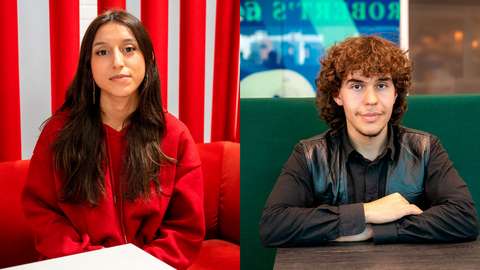Espoo’s upper secondary schools offer study opportunities for every young person
The City of Espoo’s new strategy, the Espoo Story, envisions Espoo as the capital city of children and young people. The first section of the Espoo Story roadmap states the following: ”In Espoo, all children and young people can succeed and fulfil their potential.” Espoo offers study opportunities and experiences of success to every young person. Read the stories of two upper secondary school students in Espoo.
Every person of compulsory education age (i.e. under the age of 18) must apply for upper secondary education. However, some students leave their upper secondary education unfinished. We aim to ensure that all young people in Espoo acquire at least an upper secondary level education. Our goal is to make vocational education and training more attractive and to make combining studies between upper secondary schools and vocational education and training easier in the City of Espoo.
The goal of the Espoo Story is to ensure that everyone, regardless of their background, can learn a wide range of skills. We work together to reduce segregation and inequality in the daily lives of children and young people. Our goal is to encourage more multilingual young people to apply for general upper secondary education. Speakers of foreign languages (mother tongue other than Finnish, Swedish or Sámi) currently make up 31,7 % of all pupils in basic education but only 13.9% of all general upper secondary school students in Espoo.
The aim of the city’s strategy is to give a larger portion of Espoo’s young people the possibility to study in local upper secondary schools. The joint application process for spring 2026 has 262 additional starting places compared to spring 2025. The number of starting places will further increase in autumn 2027 with the opening of the new Kiviruukin lukio upper secondary school. Kiviruukin lukio has also applied for authorisation to provide education in English, intended for young people who lack sufficient skills in Finnish and Swedish. This would enable general upper secondary school studies for young people whose families have just recently moved to Espoo.
Two upper secondary school students with immigrant backgrounds
Jana Mozer is a third-year student at Kuninkaantien lukio upper secondary school. At the age of 8, she moved to Finland from Iraq. ”I studied Finnish and worked on second class level studies at the same time. I learned the language in a year and then moved to a regular classroom,” Jana reminisces.
Applying for upper secondary school felt obvious for Jana, since her parents are highly educated and had encouraged her to study hard since fifth grade. ”University was one main factor behind my choice, as graduating from upper secondary school makes it easier to get into a university,” Jana explains. After upper secondary school, she intends to apply to the Aalto University School of Business.
In Kuninkaantien lukio upper secondary school, only 8% of all students speak something other than Finnish or Swedish as their native language. ”Before I applied, I was constantly worried whether I would really be welcome. But when I entered Kuninkaantien lukio, people accepted me as I am,” Jana says.
Alex Chirca graduated from Etelä-Tapiolan lukio upper secondary school’s International Baccalaureate (IB) programme at the end of August. Alex moved from Romania to Finland eight years ago. He lived in Naantali during his lower secondary school years.
Like Jana, Alex also saw upper secondary school as the obvious choice. He had already felt a need to find more international and open-minded people during basic education. Alex eventually decided to apply for the IB programme at Etelä-Tapiolan lukio upper secondary school. He believed he would find like-minded people in an international school. ”Moving to Espoo at the age of 16 worried my parents, but for me it was the best decision ever,” Alex says.
The IB programme at Etelä-Tapiolan lukio is very international, with students from many different backgrounds. 63% of students speak something other than Finnish or Swedish as their native language. Alex did indeed meet many interesting and internationally oriented young people there. He found plenty of pals, but no good friends. This didn't bother Alex: ”You don’t have to belong to any specific group in upper secondary school; you’ll still find your own people,” Alex says.
Alex's parents have both completed a higher education degree. Alex notes that his parents and other people close to him have always encouraged him: ”We’re rooting for you, wherever you want to go.”
